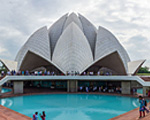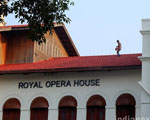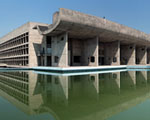|
Destination News |
 |
|
5 interesting
facts about the
Bahai Lotus
Temple in Delhi
that you must
know! |
| |
|
| |
The Lotus
Temple also
known as the
Bahai House
of Worship
or Bahai
Mashriqul-Adhkar
Temple is
one of the
best
architectural
marvels in
the county
in modern
times. The
white marble
structure is
also called
the Taj
Mahal of the
20th century
but it is so
much more
than just a
splendid
piece of
architecture.
It is a
place where
several
visitors
from all
across the
globe come
for peace,
meditation,
prayers and
study.
Located in
New Delhi,
the Lotus
Temple is a
famous
tourist
attraction
of the city.
Unlike other
places of
worship
which
usually have
an idol of a
deity people
pray to,
asking for
either
forgiveness
or something
that they
deeply
desire, the
Lotus Temple
is a rather
unique place
of worship.
It is known
for its
beautiful
flower-like
architecture
and
marvelous
ambiance
that make it
a popular
tourist
attraction
for people
of all
faiths. The
Bahai Lotus
Temple is
one of the
world’s most
beautiful
religious
buildings
and a
must-visit
when in
Delhi.
Here are
some amazing
facts about
the Bahai
Lotus
Temple:
1. The Bahai
Lotus temple
was designed
by Iranian
architect
Fariborz
Sahba in the
shape of a
lotus as it
is common to
several
religions
including
Hinduism and
Buddhism. He
has won
several
international
awards for
this
brilliant
piece of
work
including
the awards
from the
GlobArt
Academy,
Institution
of
Structural
Engineers
and more. It
also gained
recognition
in several
publications
in the world
like the
Encyclopedia
Britannia
and Guinness
World
Records.
There have
been stamps
of the Lotus
Temple,
books and
even musical
compositions
created to
showcase its
beauty and
grandeur.
2. The
temple was
completed in
1986 and is
one of the
most visited
places in
the world.
There are
nine sides
to the
temple
formed by 27
marble
petals,
arranged in
groups of
three. The
nine doors
lead to a
central
prayer hall
that has a
capacity of
2500 people
and is about
40m high.
The floor
inside the
central hall
is also made
of marble.
The marble
used comes
from Greece,
from the
Penteli
Mountain.
Many other
Bahai Houses
of Worship
were built
using the
same marble.
The entrance
of the Lotus
Temple is
also very
enchanting
with ponds
and gardens
welcoming
you to the
gates of the
temple. The
total area
of the place
is 26 acres.
3. It is in
line with
the
teachings of
the Bahai
faith
believing in
the Oneness
of God, the
Oneness of
Religions,
and the
Oneness of
Mankind. As
such, people
of all
religions
and races
are welcome
in the
temple as it
is a place
to worship
the creator
of the
universe and
not one
particular
deity. There
is no idol
to be
worshipped
and people
of any
faith, case,
creed are
welcome
inside. Even
though
everyone is
welcome, no
ritualistic
ceremonies
can be
performed
inside the
Lotus Temple
nor can
anyone
deliver
sermons.
However, you
can chant or
read
scriptures
of Bahai and
other faiths
too, in any
language.
You can even
set them to
music by
choirs but
you cannot
play any
musical
instrument
inside the
temple. The
Bahai
community
offers four
activities
called the
core
activities
for those
who are
interested
in the Bahai
way of life.
These
activities
are
Children’s’
Classes,
Junior Youth
Classes,
Devotional
Meetings and
Study
Circles.
4. The
temple is
visited by
more than
four million
people every
year with an
average of
more than
10,000
visitors
daily.
According to
Bahai
scripture,
the House of
Worship
cannot have
any
pictures,
statues or
images
displayed
inside.
However, the
lotus is not
an essential
part of
Bahai
scripture as
it states
that all
Bahai
structures
should have
a nine-sided
circular
shaped
structure.
Even so,
most of
Bahai
temples have
a
lotus-shaped
structure.
The Bahai
House of
Worship in
Delhi is one
of seven
such houses
of worship.
The other
six are at
Sydney in
Australia,
Panama City
in Panama,
Apia
inWestern
Samoa,
Kampala in
Uganda,
Frankfurt in
Germany and
Wilmette in
USA.
5. It is
interesting
to learn a
few facts
about the
history of
how this
temple was
constructed.
The area on
which the
temple is
constructed
was bought
from the
money
donated by
Ardishir
Rustampur of
Hyderabad.
He gave away
all his
life-savings
in 1953 for
the temple
to be
constructed.
But it was
not until
1976 that
Iranian
architect
Fariborz
Sahba was
approached
for
designing
it. A
UK-based
firm named
Flint and
Neil was
given the
structural
design
project
while the
construction
project was
undertaken
by ECC
Construction
Group. The
Lotus Temple
is one of
the first
temples in
Delhi to use
solar power.
Its total
electric use
is 500 KW of
which 120 KW
is provided
by solar
power. When
you visit
the Lotus
Temple, also
visit the
Information
Centre which
houses a lot
of details
of the Bahai
faith in the
form of
texts,
photographs,
film,
scriptures,
etc. There
is also an
audio-visual
room and a
library
where
religious
books are
kept for
visitors.
You can
browse
through them
if you like. |
|
 |
|
Mumbai's
magnificent
Royal Opera
House reopens to
a spectacular
opera
performance |
| |
|
| |
When it was
inaugurated
in 1911 by
King George
V, the Royal
Opera House
opened in a
different
city. It was
a city where
the
well-heeled
descended
from
horse-drawn
carriages
onto cobbled
streets to
watch live
performances
in baroque
settings.
The
structure
was built by
Jahangir
Karaka, who
made his
money in
coal, and
Calcutta-based
entertainer
Maurice
Bandmann. It
featured
Minton floor
tiles, cast
iron
balustrades
and
chandeliers
donated by
the
pre-eminent
Jewish
family of
the time–the
Sassoons.
In the early
1920s, as
movies
became the
primary form
of
entertainment,
the Opera
House turned
into a
cinema hall.
Rafique
Baghdadi,
journalist
and city
historian,
documents
how a French
production,
Pathe,
rented the
hall to show
films. And,
“in May
1927, the
first Indian
demonstration
of ‘Phonefilm’,
a process
that
synchronised
sound with
picture,
took place
here”. In
addition to
screening
movies, the
Royal Opera
House also
became a set
for films.
After a gap
of 23 years,
the Royal
Opera House
in Mumbai
saw the
spectacular
performance
-- ‘Rise up
to the Gods’
at its grand
opening.
After a puja
on October
18, the
curtains
goes up once
again in the
baroque-style
building for
the opening
night
featuring a
film
festival on
October 20
followed by
an opera
performance
by Rozario
the next
day,
organised by
the owners
of the
property
Maharaja
Joytendrasinhji
Jadeja and
Maharani
Kumud Kumari
Jadeja.
Mumbai-born
British
soprano
Patricia
Rozario
mesmerised
the audience
by her
performance
at the
milestone
reopening.
Rozario
along with
her husband
performed
nine songs
in a
powerful
30-minute
show.
Those
attending
the relaunch
was a team
of
conservationists
who has
worked hard
to restore
Opera House
to its
original
glory, with
the original
box-frame
seats and
chandeliers.
A team of
conservationists
has worked
hard to
restore
Opera House
to its
original
glory, with
the original
box-frame
seats and
chandeliers.
According to
architect
Abha Lambah
Narian who
worked on
the project,
“The ceiling
has been
restored to
the original
baroque
design. Help
of two
conservators
has also
been taken
to restore
the stained
glasses and
the painted
panel.”
In its new
avatar, the
574-seater
will include
state of the
art
acoustics –
with
valuable
inputs and
support from
HARMAN
International
(India) and
stage craft,
lighting and
air
conditioning..
The
exclusive
event was
attended by
a private
audience.
The royal
family of
Gondal – the
owners of
the venue –
have worked
towards
ensuring the
complete
restoration
of this
centre under
the watchful
eye of
conservation
architect
Abha Narain
Lambah. |
|
 |
|
New UNESCO
Sites the Latest
in India Travel |
| |
|
| |
India has
been a
bucket-list
destination
for
travelers
worldwide
since
recreational
travel first
began. Tour
experts with
whom Travel
Agent spoke
for our
annual India
Focus
earlier this
year were
upbeat about
everything
from the
country’s
continually
improving
infrastructure,
world-class
hotels,
unique river
cruise
experiences,
and
increasing
popularity,
especially
among
Millennials
and luxury
travelers.
India is
such a large
and diverse
country that
agents
booking
first-time
visitors
must be
extra
careful to
discern
precisely
what these
clients wish
to see and
experience
in the time
allotted.
The lure for
repeat
travelers is
that there
always seems
to be
something
new — or
something
they missed
— that calls
them back.
Here is an
update on
the latest
developments
in India,
including
new hotels
and tours,
to consider
while
planning
your next
itinerary
there.
A recent
decision by
UNESCO has
added both
the Capitol
Complex in
Chandigarh
and
Khangchendzonga
National
Park in
Sikkim to
the growing
list of
World
Heritage
Sites. The
Capitol
Complex,
designed by
Le Corbusier
in the 1950s
to represent
a modern,
independent
India, is
one of the
seven works
added by
UNESCO
recently.
At
Khangchendzonga,
the Heritage
recognition
for both
natural and
cultural
significance
is expected
to help
regulate the
recent high
influx of
visitors by
keeping any
negative
impacts of
tourism to a
minimum, all
the while
promoting
the state as
a prime
destination
for
eco-tourism.
In Agra,
India’s
iconic Taj
Mahal will
remain open
to visitors
during an
ongoing
restoration,
which is
slated for
completion
in 2018. The
mud-cleaning
process
requires the
minarets to
be covered
with
scaffolds,
disrupting
the view for
visitors. To
date, two of
the minarets
have been
cleaned and
two are
still in the
process of
being
completed.
The cleaning
of one of
the outer
arch has
also begun,
which is to
be followed
by the
cleaning of
all eight
inner and
outer arches
and the main
dome. |
|
|
|